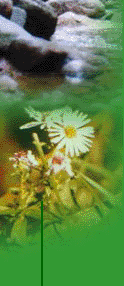|
| 1. |
Knowledge of Trees |
 |
 |
A. |
Identify common species without a key and specific
or unusual species of trees or shrubs through the use of a key. |
 |
 |
B. |
Describe typical tree growth and life cycle. Recognize
defects that effect a tree’s quality and resource potential. |
 |
| |
C. |
Explain the cause and effect relationships between
environmental factors (light, soil and moisture) and tree growth. Be able to interpret these effects in the growth rings of
a sample of wood (either a “tree cookie” or core taken with an increment borer). |
 |
| Students should recognize oaks,
maples, ash, black cherry and other tree species with high timber and wildlife values. Special attention should be paid to
shade tolerance and soil moisture requirements of these species). |
| II. |
Knowledge of Forest Ecology. |
 |
 |
A. |
Explain general forest typing based on the dominant
tree species. Describe major forest types found in Pennsylvania. |
 |
 |
B. |
Explain typical forest structure (canopy, understory
and ground layers) and crown classes. |
 |
 |
C. |
Explain typical forest succession from open areas
to closed canopy and back again. |
 |
 |
D. |
Explain how wildlife habitat relates to the forest
plant community (i.e. tree species present, age structure, snags and dead-and-down trees, availability of food and riparian
zones).
|
 |
| Students should be able to
apply the preceding concepts of forest ecology to describe a specific forest community, its age structure, vertical structure
and stage of succession. |
 |
| III. |
Knowledge of Forest Benefits and Resources |
 |
 |
A. |
Be able to summarize the general history of Pennsylvania’s
forests from the arrival of the first humans 10,000 years ago to the present. |
 |
 |
B. |
Describe values and benefits of forests for recreation,
wildlife and watershed quality |
 |
 |
C. |
Demonstrate the use of common forestry equipment
(Biltmore stick, diameter tape and clinometer) to measure tree diameter, height and calculate wood volume. |
 |
 |
D. |
List products and uses of the following commercial
species grown in Pennsylvania: Red & White oaks, Black cherry, White ash, hickories. |
 |
 |
E. |
Describe the benefits of maintaining trees in urban
and suburban communities and factors effecting their health and survival. |
 |
| IV. |
Forest Resource Management and Protection |
 |
 |
A. |
Explain the uses of these silviculture techniques
in even-aged and uneven-aged forest management: thinning, clear-cutting, seed-tree method, shelterwood method, and selection
method. Describe the practices of “high grading” and “diameter limit” cutting. |
 |
 |
B. |
Identify and describe the life cycle and impacts
of common forest pests in Pennsylvania, especially white-tailed deer, gypsy moth and hemlock wooly adelgid & invasive
plants. |
 |
 |
C. |
Explain the role of fire in forest ecosystems.
Describe the basic principles of wildfire prevention and control. |
 |
 |
D. |
Explain the potential for pollution from timber
harvesting and the practices used to minimize erosion and sedimentation. |
 |
 |
E. |
Summarize State and local regulations and programs
pertaining to timber management including Pennsylvania’s Right to Practice Forestry Act and the Forest Stewardship Program. |
 |
| Students should be able to
apply silvicultural concepts and methods to suggest recommendations and goals when given hypothetical forest management situations. |
 |
Reference Materials |
Most of the materials on the
reference CD are excerpted from Sustaining Penn’s Woods a kit of interdisciplinary instructional activities on Pennsylvania
forests and land use. They are aligned with the Environment and Ecology Standards. Sustaining Penn’s Woods was produced
by the PA Department of Education–Office of Environment and Ecology and distributed to all middle schools in the Commonwealth.
Other materials are drawn from Forest Stewardship Program publications produced by the Pennsylvania State University.
Common Trees of Pennsylvania (Emphasis is on species with high values for wildlife
and timber resources, (ash, oaks, maples, hickories, cherry and conifers). You can download this booklet from the DCNR-Bureau
of Forestry website at www.dcnr.state.pa.us/forestry/commontr/common.htm
Common Insect and Disease Pests of Pennsylvania Forests
- You can find updated information on the DCNR-Bureau of Forestry website at www.dcnr.state.pa.us/forestry/pests/intro.htm and at www.dcnr.state.pa.us/forestry/pests/foresthealth.htm
Other On-line Resources
Information on Pennsylvania native wild plants, invasive exotic plant problems and ginseng
can be found at www.dcnr.state.pa.us/forestry/wildplant/wildplant.htm.
U.S. Forest Service Forest Inventory and Analysis data on
Pennsylvania can be found at www.fs.fed.us/ne/fia/states/pa/pa.html
The Penn State College of Agricultural Sciences – School
of Forest Resources provides a Sustainable Forestry Teacher Resource Center, which includes lesson plans in sustainable forestry,
natural resources, water, and wildlife. The lesson plans have been designed by teachers for actual use in the classroom and
meet Pennsylvania's environmental and ecology education standards. Each lesson plan indicates subject matter, grade level,
and regional applicability. The lesson plans can be adapted to fit your location. These resources can be found at http://rnrext.cas.psu.edu/
Additional sources of helpful information, illustrations
and background materials are available in libraries and bookstores. |
 |
 |
Peterson Field Guide Series, Published by
Houghton Mifflin Company |
 |
 |
1. |
A Field Guide to Eastern Forests, by John C. Kricher
and Gordon Morrison.
Good coverage of several complex topics:
Stratification pg. 7; Predicting a Forest’s Future pg. 22; The Forest Food Chain and Ecological Pyramid pg. 26; Chapter
4 Disturbance and Pioneer Plants, Ecological Succession: The Process of Vegetation Development Over Time pg. 93-140; Tree
Trunks and Growth Rings pg. 301. |
 |
|
2. |
For help with tree identification try:
A Field Guide to Trees and Shrubs, by George A. Petrides
|
|




